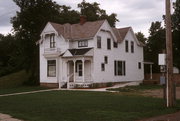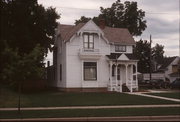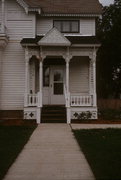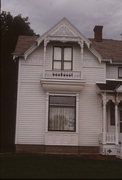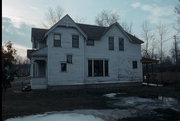| Additional Information: | A 'site file' exists for this property. It contains additional information such as correspondence, newspaper clippings, or historical information. It is a public record and may be viewed in person at the Wisconsin Historical Society, State Historic Preservation Office.
MOVED TO MADISON ST. ON 6/28/1994 TO MAKE ROOM FOR THE LUTHER HOSPITAL EXPANSION. ORIGINALLY LOCATED AT 429 CHESTNUT ST.
Hand and machine-made detail distinguish the Brady Anderson House situated on the east bank of the Chippewa River. The two-story clapboard-sided residence is characterized by an irregular roofline, the product of a number of gabled elements. The main facade is dominated by a gabled projection and an entrance porch. The projection features a balcony supported by a flared base rising from the large window on the first floor. Slim and delicately-shaped turned posts reach from the base to the gable which shelters the balcony. Framed within the gable is a triangular area filled with an elaborately carved floral and leaf design fashioned by the original owner. Similar carving is located on the valance panel, on the gable and valances of the entrance porch, and on gables located on the east and west elevations. The entrance porch is located at the northwest corner of the building. Its pent roof rests on squared posts accented with carved brackets. Additional facade details include a paneled strip extending horizontally from the balcony to the ends of the gabled section of the house and finely-cut roof-edge trim. All of the window openings are distinctly framed, with many of the surrounds containing leaf patterns.
The Brady Anderson House is Eau Claire's prime representative of a decorated Victorian-era cottage. Constructed in the years 1892-94, the distinctive dwelling is lavishly ornamented by detail provided by the original owner/carpenter, Brady Anderson. According to local residents, Mr. Anderson was known in the community for his carving ability. The building is intact architecturally and also served as the Red Carpet House of the Luther Hospital, a gift shop operated by the women's auxiliary of the hospital.
The Brady Anderson House is also historically significant. Waldemar Ager (1869-1941) was a recognized member of Eau Claire's Norwegian community, working as an editor of the Norwegian weekly, Reform. Beyond the city limits, he distinguished himself as a lecturer (he advocated the temperance cause) and as a writer, authoring a number of books and articles that contributed to the quality of Norwegian-American fiction. He also had a by-line for the Minneapolis Tribune. Ager lived in the house from c.1905 until 1941.
Ager, born in Fredrickstad, Norway, migrated with his family to the United States in 1885 and settled in Chicago where he found employment as an apprentice printer in a Norwegian-American shop. Soon after he began writing anonymous articles in the paper. He also became involved with temperance organizations and upon receiving his naturalization papers joined the Prohibition Party. Ager was particularly appalled by the sight of young Norwegian immigrants "wasting their money and lives on liquor, thus bringing disgrace both on themselves and on the land of their birth."
In 1892 Ager moved to Eau Claire and worked as a printer for the five-page publication, Reform. The small paper, the successor to the Norwegian weekly, Arbeideren (The Workman), was organized in 1887 by two temperance advocates, George Engelstad and Ole Olson. Engelstad returned to Norway in 1890, leaving Olson as both editor and business manager. In 1896 Ager assumed the latter position and following Olson's death in 1903 also became the paper's editor. As editor, Ager spoke out on temperance issues. The paper, directed to the city's substantial Norwegian population, most of which was affiliated with the lumber industry, featured temperance articles and information but also contained news from Norway and news about Norwegian-Americans. The publication was one of two foreign-language papers in Eau Claire that survived beyond a few years, the other being Der Herold, a German language paper. Reform ended publication in September 1941, a month after Ager's death.
Ager augmented his newspaper work with lectures on both temperance and Norwegian-American affairs. He lectured widely on the temperance issue and became an influential member of the Wisconsin Prohibition Party. At one time the Eau Claire editor was a candidate for lieutenant governor on the Prohibition ticket. Concerning Norwegian-American affairs, Ager believed in the maintenance of Norwegian traditions but hoped that these might be absorbed and "become part of the American culture - the culture that is to result when the American `melting pot' process is completed." As a member of the Norwegian Society of America, he stressed this point of view.
Ager's literary output was tremendous. He was responsible for four novels, eight collections of short stories and essays, two short novels, and a history of the 15th Wisconsin Volunteer Infantry, a unit composed entirely of Norwegian soldiers. All of these works were written in Norwegian. Theodore Blegen, a noted ethnic historian, included the following description of Ager in his Norwegian Migration to America: "Ager combined professional skill in writing with sharp observations and a gift for ironical humor. His Kristus for Pilatus ("Christ Before Pilate" - 1911), Gamlelandets Sonner ("The Sons of the Old Country" - 1926), and Hundeoine ("Dog Eyes" - 1929; translated into English as I Sit Alone) were probing social and psychological studies that won for him a high place among Norwegian-American writers.
Throughout his career, Ager received a number of honors. These included decorations by Haakon VII, King of Norway, and awards from the Norwegian Society of America and the Norwegian Library Association. Ager died in Eau Claire in 1941.
2014- "This distinctive dwelling is lavishly ornamented by handmade and machined detail provided by the original owner-carpenter, Brady Anderson,, locally known for his carving ability. Within the gable at the front of the house are elaborately carved floral and leaf designs.
Waldemar Ager, a leading member of Eau Claire's Norwegian community, was editor of the Norwegian-language weekly Reform, and had a byline for the Minneapolis Tribune. He augmented his newspaper work with lectures on both temperance and Norwegian-American affairs. His literary output included short stories, essays, two short novels and a history of the 15th Wisconsin Volunteer Infantry, all written in Norwegian. His novel Sons of the Old Country is set in Eau Claire and tells the story of the conflicts of Norwegian immigrants with their Irish co-workers and English bosses. His son Trygve, also a writer, has translated it into English. Waldemar Ager's writings earned him recognition from the King of Norway, the Norwegian Society of America and the Norwegian Literary Association. He died in Eau Claire in 1941.
The Ager House was moved to its present site from 429 Chestnut Street in 1994. It is maintained by the Waldemar Ager Association."
-"Eau Claire Landmarks: Designated Historic Properties in Eau Claire, Wisconsin", Eau Claire Landmarks Commission, P.O. Box 5148, 2016. |
|---|

